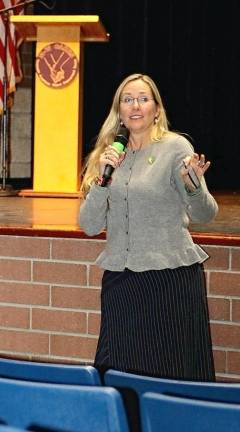M-W District chooses love
Scarlett Lewis, who lost her son in the Sandy Hook Elementary School shooting, has channeled her grief to promote social and emotional learning.

How would you react if your child were killed in a school shooting?
That is a question no parent would ever want to have to answer. But for Scarlett Lewis, mother of Sandy Hook Elementary School shooting victim 6-year-old Jesse, murdered in his first-grade classroom in Newtown, Conn., in December 2012, she had no choice.
So, she chose love.
After burying her son and processing her profound grief, Lewis channeled her emotions into creating the “Choose Love” movement, a mission on which she has worked tirelessly for the past six years. She has traveled the country and the world, spreading her message promoting social and emotional learning, comprised of courage, gratitude, forgiveness, and compassion, the four pillars of the “Choose Love” Enrichment Program.
The evening of Oct. 30, Ms. Lewis presented a "Choose Love" family event at the M-W high school, sharing the basic precepts of her program of social and emotional learning with the Monroe-Woodbury school community. The free social emotional program was presented through the efforts of M-W Pupil Personnel Services and the district’s SEPTA (Special Education PTA) organization.
'An effective social-emotional tool'
The next day, Lewis visited a number of schools throughout the district to discuss the program and its implementation in Monroe-Woodbury, which began last year as a pilot program at the elementary level. M-W schools are in the process of incorporating the “Choose Love” curriculum at the K-8 level throughout the district in a phased implementation.
“Choose Love is a unique program that is all encompassing, research-based and scientifically proven to be an effective social-emotional tool,” said M-W Director of Pupil Personnel Christine Ricker. “The Choose Love equation is a powerful reminder of the important components of the program; courage, gratitude, forgiveness and compassion in action. The program is user-friendly for teachers and school counselors, and the home connection provides parents with short videos that align with the classroom lessons.
Most importantly," Ricker added, "the students and staff love the program, and we are already seeing results.”
'Compelling and provocative'
“I found Scarlett’s presentation, particularly the statistics that she presented, quite compelling and provocative,” noted presentation attendee Kelly Paulsen, Pine Tree Elementary Parent Teachers Association Executive Board President. “Implementing the Choose Love movement/program into our school’s curriculum would be a great way to help develop their social emotional health which is vital (and often overlooked) for our children to grow into healthy and productive contributors to society.”
Acknowledging that today’s young people face many challenges (bullying, mental illness, substance abuse, for example), Lewis stressed the importance of social emotional learning and how parents and schools can work together to provide love and support to young people.
'The right tools
She started the Jesse Lewis Choose Love Movement to foster the understanding that with the right tools, schools, parents and communities can educate and encourage individuals to choose loving thoughts over angry thoughts.
“Choose Love is a different program in that it cultivates a culture (that includes homes and communities) of love, connection, and belonging," Lewis said. "Although we can’t always choose what happens to us, we can always choose how to respond. Children can learn to choose a loving thought over an angry one.
“When a child realizes that they have the power to positively impact themselves as well as those around them," this mother added, "it is empowering and perpetuates their positive actions and interactions.”
The following is a link to the M-W Choose Love presentation video: